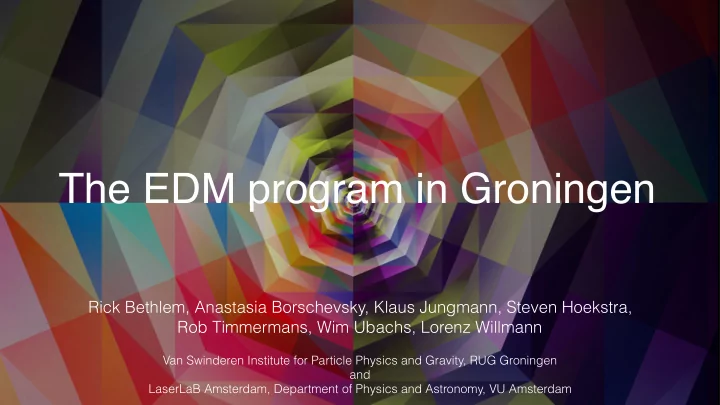

The EDM program in Groningen Rick Bethlem, Anastasia Borschevsky, Klaus Jungmann, Steven Hoekstra, Rob Timmermans, Wim Ubachs, Lorenz Willmann Van Swinderen Institute for Particle Physics and Gravity, RUG Groningen and LaserLaB Amsterdam, Department of Physics and Astronomy, VU Amsterdam
Main message of this talk: 1. Most exciting low-energy particle physics experiment 2. Ambitious and realistic plan 3. Team with perfect expertise for serious impact The EDM program in Groningen Rick Bethlem, Anastasia Borschevsky, Klaus Jungmann, Steven Hoekstra, Rob Timmermans, Wim Ubachs, Lorenz Willmann Van Swinderen Institute for Particle Physics and Gravity, RUG Groningen and LaserLaB Amsterdam, Department of Physics and Astronomy, VU Amsterdam
Is the electron round? The Electric Dipole Moment of the electron (eEDM)
Is the electron round? The Electric Dipole Moment of the electron (eEDM) T P E B E B E B an eEDM would violate P and T Symmetry -> violates CP symmetry by CPT theorem
How to measure an eEDM? interpretation choice of system experiment production state preparation interaction detection repeat • Place N electrons in parallel E and B fields • Measure the precession frequency for time τ • Reverse relative direction of the fields, measure again • EDM signature: shift of precession frequency
Best measurements so far 2011: YbF molecule result (Hinds et al, London) 2014: ThO molecule result 2002: best experimental limit (DeMille, Gabrielse, Doyle, Yale/Harvard) using thallium atoms Statistical limit achievable in our proposal HfF + / ThF + results multi- from Cornell team (Boulder) in Higgs between YbF and ThO results left right extended (unpublished) symmetric technicolor Standard Model lepton fm avour- alignment changing split SUSY SO(10)GUT seesaw neutrino Yukawa couplings The current accidental approx. approx. exact experimental eEDM cancellations CP universality universality heavy limit constrains SUSY naive SUSY fermions 10 − 25 10 − 26 10 − 27 10 − 28 10 − 29 10 − 30 10 − 31 10 − 32 10 − 33 10 − 34 10 − 39 10 − 40 particles up to 3 TeV d e ( e cm)
Particle physics with molecules? Reduced sensitivity (~ 10 -10 ) to Huge (~10 6 ) enhancement effects! magnetic fields perpendicular to E 20 15 E eff (GV/cm) M F : -1 0 +1 10 F=1 5 N=0 J=1/2 0 0 10 20 30 F=0 Applied field E (kV/cm) The valence electron is exposed to the no fake-EDM from motion in magnetic field internal field of the polarised molecule
Improve on ongoing experiments? The best you can do: shot-noise limit on statistical error σ d = ~ 1 We aim for a next- Number of generation eEDM √ e detected molecules 2 E e ff τ N experiment using cold molecules Coherent measurement time Effective electric field
Recent progress in cooling methods allows for new generations of precision measurements Experiments so far have fountain? trap? been done in beams: t ~ 100 ms t ~ 1-10 s L ~ 0.5 m t ~ 1 ms L ~ 0.5 m L ~ 0.5 mm L L L molecules trapped in laser focus slow vertical beam
Our approach F=1 choice of the system: rotational ground state of BaF N=0 (barium-monofluoride) F=0 cryogenic source decelerator cooling state preparation interaction detection guide key ingredient: Best possible combination of intense, slow and cold beam interaction time and N
cryogenic source guide decelerator cooling state preparation interaction detection I. Intense: cryogenic source Cryogenic Supersonic 0 100 200 300 400 500 600 velocity (m/s) ThO cryogenic source • Use electrostatic guide to bring molecules to decelerator • N: ~ 10 10 molecules/shot through the guide, based on BaF, YbF, CaH and ThO results • Long pulse is not an issue in a beam experiment • 10 Hz operation demonstrated on BaF cryogenic source with moving pill. • Novel but proven technology
cryogenic source guide decelerator cooling state preparation interaction detection II. slow: the decelerator Existing machine @ VSI, SrF deceleration demonstrated
cryogenic source guide decelerator cooling state preparation interaction detection II. slow: the decelerator 3 % of the low-field seeking molecules decelerated to 30 m/s 120 50 110 40 100 30 90 20 intensity (arb.units) 80 10 70 0 22.0 22.5 23.0 23.5 60 50 40 BaF 30 deceleration 20 simulation 10 10 12 14 16 18 20 22 24 26 28 30 arrival time (ms)
cryogenic source guide decelerator cooling state preparation interaction detection III. cold : laser cooling Transverse laser cooling of BaF: essential to be able to profit from slow beam Without cooling, density loss v'=2 would compensate interaction v'=1 v'=0 time gain. A 2 Π 1/2 0.003 0.045 0.086 0.95 Comparable to CaF, SrF, SrF: 0.871 • Excited state lifetime ~ 50 ns 0.048 • Franck-Condon factors good • Convenient diode laser wavelengths • optical molasses laser cooling to 200 829 nm microKelvin in 3 - 5 ms 862 nm 896 nm 860 nm v''=2 X 2 Σ initial v | max. 5 m/s v''=1 v''=0 beam expands final v | ~ 20 cm/s
Our approach F=1 choice of the system: rotational ground state of BaF N=0 (barium-monofluoride) F=0 cryogenic source decelerator cooling state preparation interaction detection guide key ingredient: Best possible combination of intense, slow and cold beam interaction time and N
The EDM team Rick Bethlem Lorenz Willmann VSI VU Lasers, spectroscopy, Molecular beams, deceleration, laser cooling molecular fountain Molecular structure calculations, Wim Ubachs Matching Molecular structure and spectroscopy beyond the Standard Model Anastasia Borschevsky VU Expertise VSI Stark deceleration, molecular EDMs, particle physics theory beams, laser cooling VSI EDMs, precision measurements, magnetic field control VSI Rob Timmermans Steven Hoekstra VSI Klaus Jungmann
EDM program within Nikhef • This EDM program is the novel, focused contribution of the VSI • It is complementary to the existing Nikhef portfolio • We look forward to collaboration opportunities on both physics and technology!
end
Recommend
More recommend